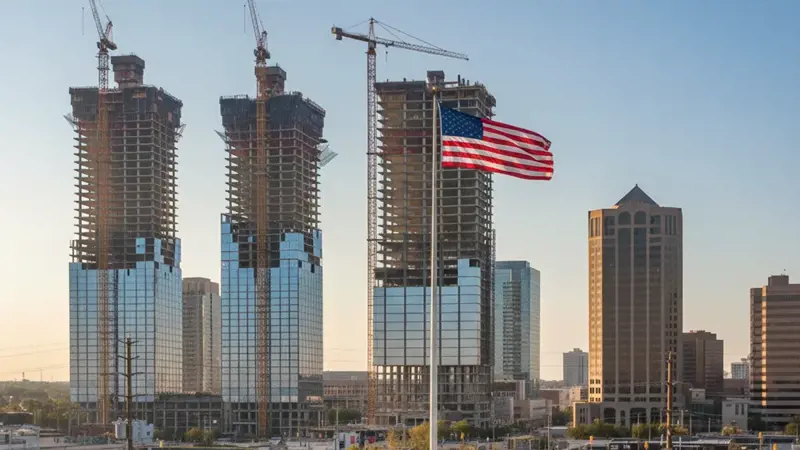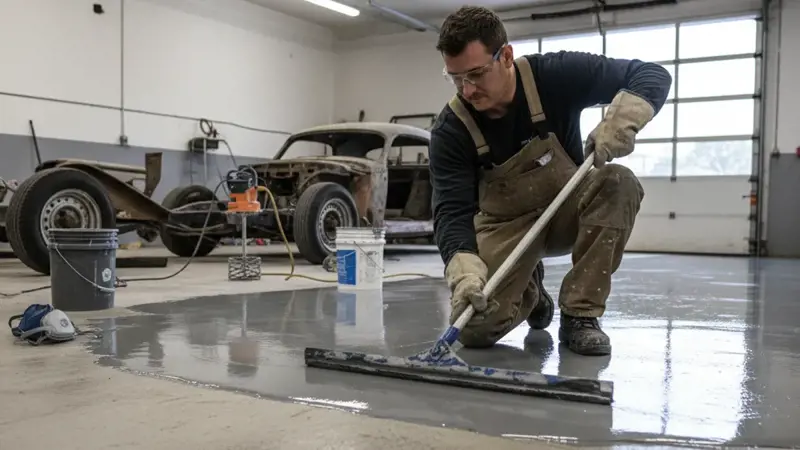Building or renovating a house can be a very tempting and exciting idea. However, financial issues often prevent us from pursuing this idea, leading to a common question: "What is the average cost of home construction?" Knowing the exact price of construction is logical for setting a budget before starting the project. You can always use a building price estimator to determine the precise cost of such a project, but have you ever considered what the key components are that contribute to the final cost of a building?
The cost of a construction project can be affected by many factors, but this text will focus on one of the most important: location. I'm sure you have heard that the cost of building a house varies by city, but why is that? After answering this question, we will review construction costs by state in the United States to help you understand what a project might cost in your specific state and city.
Why Your Location is the Ultimate Cost Driver
It may seem unusual, but the location where you build or renovate is the most significant factor in your project’s final cost, accounting for almost 30% to 40% of the total cost. Construction is essentially a localized industry; this means that costs can vary significantly from one city to another. Here are the specific reasons for that:
- Labor Costs: This is the first differentiator; the wages for skilled workers, such as electricians, carpenters, and architects, significantly vary according to the total cost of living in that state, unionization rates, and local builder recruitment agencies. In states like California and New York, which have higher living expenses, average hourly wages for workers are higher than in other states.
- Material Supply Chains: Certain materials, such as concrete, have a uniform price nationwide. However, some states have local sources for providing the materials needed for their use. States without these sources must buy materials from other states. The cost of transportation can drive up the price in these places.
- Permit Fees and Regulatory Environment: Before the construction project begins, you must obtain the necessary permits from your local authorities. Every state has its own set of building codes, zoning laws, and permit fees. For example, some states have strict energy efficiency regulations, or some have earthquake-resistant building codes that require more expensive materials and construction. Additionally, specific insurance rules can be pricier.
- Land Costs: The price of the land on which you want to build a home can affect your budget. A state with higher land values typically experiences a higher construction rate. For example, in Hawaii, the average home construction cost per square foot is $300–$550, while in Washington, it is $200–$350. Meanwhile, in some states, such as Mississippi, the land value ranges from $95 to $150.
- Market Demand & Competition: Areas that experience a fast growth rate or a housing boom, such as Austin, Dallas, and Houston, can lead to a surge in demand for construction, materials, and labor costs, which can overwhelm the state's capacity to meet the supply; therefore, prices will increase. In places like West Virginia or Arkansas, where construction activity is low, lower costs can be expected.
- Climate & Geography: Some places, like Florida, Louisiana, California, and Colorado, that are prone to extreme climatic and environmental conditions like hurricanes, heavy snow, floods, and wildfires often require more robust foundations and additional reinforcements, which will add to the cost
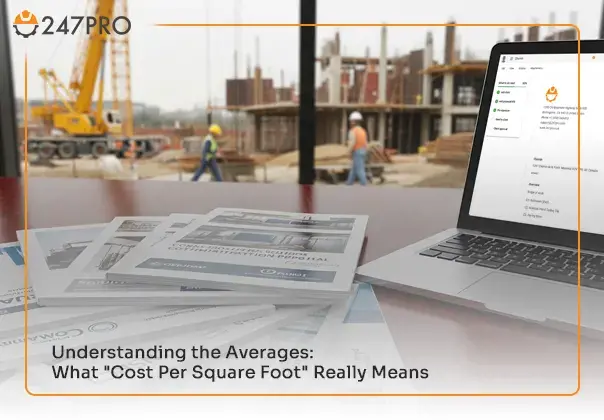
Understanding the Averages: What "Cost Per Square Foot" Really Means
When you want to find out about the average home construction cost, we often encounter phrases like “residential construction cost per sq ft,” but what exactly does that mean, and what does it include?
- Average Cost Per Square Foot: This phrase typically represents the cost to construct the structure itself, including materials, labor, and basic finishes. For example, if the average price per square foot of a building in Nevada is $155, it means that, on average, building a 1000-square-foot building would cost $155,000.
- What elements are not included? Typically, the residential construction cost per square foot does not include the expenses of purchasing land, site preparation, utility connections, or significant unexpected challenges.
Understanding the average home construction cost is a suitable starting point for planning your budget, but it doesn’t provide the exact number for the entire project. You can use an online cost estimator or consult a specialist in this field to get the actual cost.

The US Construction Cost Landscape: A State-by-State Snapshot (2024-2025 Averages)
With land costs excluded, these numbers show the average construction costs by state for a new home, which is typically between 2,000 and 2,100 square feet. These prices are estimates, and the final cost can vary considerably based on the home's design, the quality of the materials used, or particular site circumstances. For precise budgeting, it is essential to get comprehensive quotes from local contractors. For simpler access, we divided the states into three tables: West, Center, and East.
The US Construction Cost State by State Per Square Foot
Mainly due to location-specific factors, the cost of building a home varies significantly across the United States.
- The West: This region always has the highest prices. Hawaii is the most expensive, with an average cost of $205 per square foot. California and Washington are close behind, with an average cost of $173 per square foot. The high demand, strict environmental rules, and high cost of living that raise wages are all reasons why these prices are so high.
- The Central Region: These are the most affordable states in the US. The Midwest and South Central regions have lower land and labor costs. Texas ($120–$270/sq ft) and Missouri ($163/sq ft) are two states that are more affordable when building a new home.
- The East: The Northeast is home to some of the most expensive states, like New Jersey ($180-$400+/sq ft) and Massachusetts ($192/sq ft), due to their closeness to major cities and limited land. The South Atlantic states, on the other hand, are cheaper. North Carolina ($115–$250/sq ft) and Georgia ($110–$240/sq ft) are more affordable.
West region states
The western states typically have the highest construction costs in the US, mainly due to factors such as high demand, higher labor expenses, and often stricter environmental regulations.
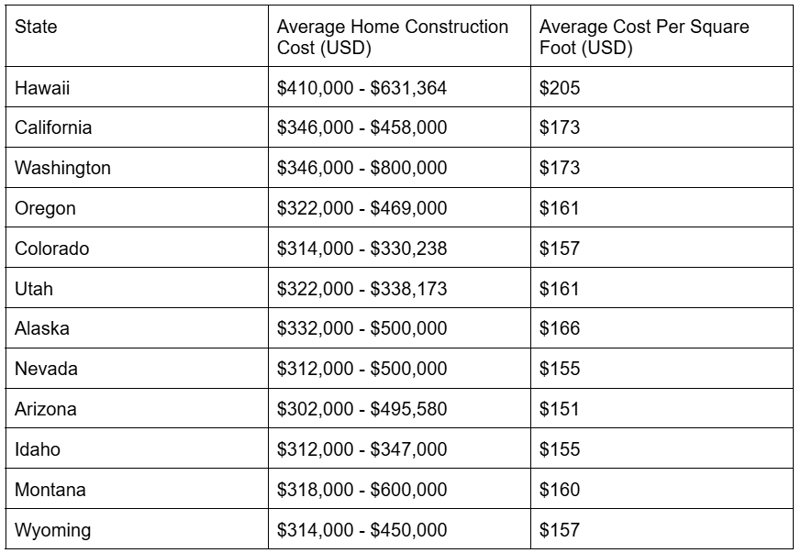
Cost to Build a House in California
California is one of the most expensive states for construction, due to its high cost of living and strict building codes. The cost to build a home in California ranges from $250 to over $600 per square foot, excluding land cost; for a 2,000-square-foot home, it would cost $500,000 to over $1,200,000. Urban areas like San Francisco face higher costs due to zoning restrictions and limited land availability.

Cost to Build a House in Colorado
Colorado’s average cost to build a house ranges from $160 to $350 per square foot, making a 2,000-square-foot home cost between $320,000 $700,000, excluding land. Mountainous terrain may increase site prep costs ($5,000-$15,000).

Cost to Build a Home in Utah
Construction costs can vary due to Utah's unique terrain and expanding population, with prices being higher near Salt Lake City and ski resorts. The average cost per square foot in Utah ranges from $150 to $320. Therefore, a 2,000-square-foot home would cost $300,000 to $640,000, excluding the land cost.

Central (Midwest & South Central) Region States
These states typically have more affordable construction costs compared to the coasts, mainly due to lower labor rates and land costs.

Cost to Build a House in Michigan
Michigan offers more affordable construction costs than coastal states, even though costs can be higher in urban areas like Detroit or Grand Rapids. In Michigan, the average cost to build a 2,000-square-foot home is between $260,000 and $440,000 ($120 and $250 per square foot).

Cost to Build a House in Texas
In Texas, the average cost of building a home ranges from $120 to $270 per sq ft; so, creating a 2,000-square-foot home typically costs between $240,000 and $540,000.

Cost to Build a House in Minnesota
In Minnesota, the average cost to build a home is $130-$280 per square foot; so, a 2,000-square-foot home would cost between $260,000 and $560,000. Cold climates raise foundation costs.

Cost to Build a House in Ohio
Building a home in Ohio can cost anywhere from $110 to $240 per square foot. A 2,000-square-foot house will cost between $220,000 and $480,000.

Cost to Build a House in Tennessee
In Tennessee, a 2,000-square-foot home typically costs between $220,000 and $460,000 to build, as the average cost is $110 to $230 per square foot. Although prices in Nashville are rising, it is still cost-effective due to the availability of inexpensive labor.

Cost to Build a House in Iowa
Iowa has some of the lowest building costs in the country, with an average cost of $90 to $200 per sq. ft.

Cost to Build a House in Wisconsin
The average cost of building a 2,000-square-foot home in Wisconsin is between $250,000 and $520,000 ($125 and $260 per sq. ft.). The cold-climate requirements for foundations and insulation offset moderate labor costs.

Cost to Build a House in Oklahoma
Oklahoma’s average cost to build a house is $100-$220 per sq. ft. The cost of building a 2,000-square-foot home ranges from $200,000 to $440,000, making it one of the most budget-friendly in the U.S.

East (Northeast & South Atlantic) Region States
The East Coast has a wide range of costs, from some of the most expensive regions in the northeast to more affordable prices in the South Atlantic.
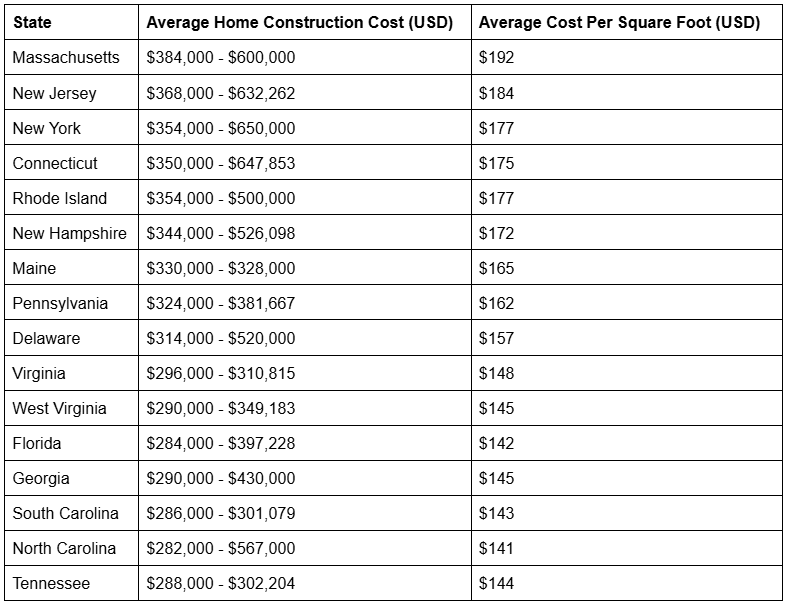
Cost to Build a House in Florida
The average cost of building a home in Florida is between $130 and $280 per square foot. Thus, it would cost between $260,000 and $560,000 to build a standard 2,000-square-foot home. Hurricane-resistant materials and the high cost of coastal land make up for low labor rates in rural areas.

Cost to Build a Home in Georgia
Since the average cost per square foot is between $110 and $240, building a 2,000-square-foot home in Georgia typically costs between $220,000 and $480,000. Being close to manufacturing centers reduces the cost of labor and materials.

Cost to Build a House in Virginia
A 2,000-square-foot home in Virginia can cost anywhere between $280,000 and $600,000 to build, with the average cost of $140-$300 per square foot. Due to zoning restrictions and demand, labor and land costs are higher in the surrounding areas of Washington, D.C.

Cost to Build a House in Maryland
The average cost of building a house in Maryland is between $180 and $380 per square foot. Labor and land costs are higher due to proximity to Washington, D.C., particularly in Baltimore. You should therefore budget between $360,000 and $760,000 for the construction of a typical 2,000-square-foot home.

Cost to Build a House in New Jersey
In New Jersey, the average cost to build a 2,000-square-foot home is between about $360,000 and over $800,000, or about $180 to $400+ per square foot. Because of the state's proximity to New York City and the limited amount of available land, these high costs are primarily caused by steep land prices and costly labor rates.

Average Cost to Build a House in North Carolina
In North Carolina, the average cost to build a 2,000-square-foot home is between $230,000 and $500,000. That's roughly $115 to $250 per square foot. The lower overall costs can be attributed to relatively low land prices and affordable labor. Major cities like Charlotte and Raleigh, however, typically have higher prices.

Cost to Build a House in Maine
In Maine, the average cost to build a 2,000-square-foot home is between $280,000 and $600,000, or about $140 to $300 per square foot. However, site preparation costs, which can range from $5,000 to $15,000, can be greatly increased by coastal locations or rocky terrain.

Why are construction costs still so high?
There are several reasons why construction costs are still high:
- Labor Market Constraints: Due to a shortage of skilled workers, the labor market is a seller's market, resulting in rising wages.
- Inflationary Pressures: Even though inflation is slowing down overall, it still affects the prices of materials, equipment, and services.
- Geopolitical and Economic Uncertainty: Trade tensions that continue to grow and the threat of tariffs on imported materials make the supply chain less stable and can cause prices to go up for essential items.
- High Demand in Certain Areas: Although residential and office construction has slowed, demand remains strong in key sectors such as data centers, manufacturing, and healthcare, keeping the overall market tight and prices high.
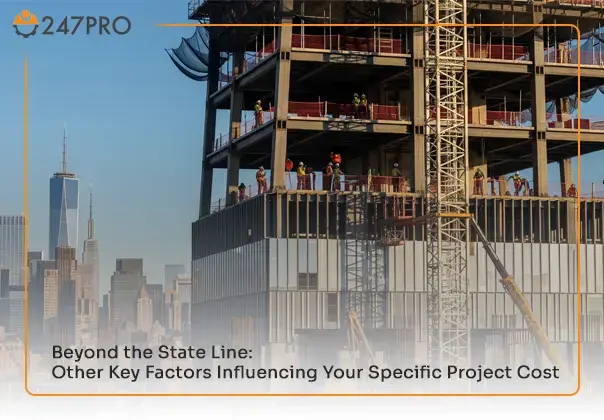
Beyond the State Line: Other Key Factors Influencing Your Specific Project Cost
While your state provides a general cost bracket, several other factors within that state will define your actual project price. Understanding these helps both homeowners get realistic quotes and contractors build accurate estimates.
- Project Scope and Design Complexity:
- A simple, rectangular ranch house will be significantly cheaper per square foot than a multi-story home with complex angles, custom rooflines, or intricate architectural details.
- For Homeowners: Every unique feature or non-standard design element adds to the cost. Be clear on your priorities.
- For Contractors: Complex designs demand more detailed plans, skilled labor, and specialized materials, all of which increase your estimate.
- Material and Finish Selections:
- This is arguably the biggest variable within any given budget. The difference between standard-grade carpet and high-end hardwood, laminate countertops versus granite, or basic light fixtures versus custom designer ones can swing a project's cost by tens, or even hundreds, of thousands of dollars.
- For Homeowners: Be realistic about your budget versus your desired aesthetics. Work with your builder to identify cost-effective alternatives if needed.
- For Contractors: Provide clear allowances for finishes and transparently show the cost implications of different material choices.
- Site Conditions and Accessibility:
- A perfectly flat, easily accessible lot with stable soil is ideal. However, sloping land requires more excavation and retaining walls. Rocky terrain increases digging costs. Sites with limited access (e.g., narrow city lots, no space for machinery) can prolong work and increase labor expenses due to manual work.
- For Both: Always conduct thorough site evaluations, including soil testing, before finalizing your budget.
- Permits and Inspections Specifics:
- Beyond the general state differences, specific cities or counties may have higher permit fees, more frequent inspection requirements, or unique local ordinances (e.g., historical district regulations, strict energy efficiency mandates) that impact costs.
- For Both: Research local regulations meticulously early in the planning phase.
- Subcontractor and Labor Quality:
- A cheaper hourly rate from a less experienced crew might seem appealing, but it can lead to costly rework, delays, and material waste. Quality, efficient labor saves money in the long run.
- For Homeowners: Don't just pick the cheapest bid. Look for licensed, insured contractors with good references and a track record of quality.
- For Contractors: Vetting your subcontractors is crucial. A reliable sub, even if costing slightly more, ensures timely and quality work.
- Unforeseen Conditions (The Contingency):
- Especially true for renovations (like a "remodel house cost estimator" project), unexpected issues can arise once walls are opened up (e.g., outdated wiring, hidden water damage, mold, pest infestations, structural surprises).
- For Both: Always allocate a contingency fund (typically 10-20% of the project's total) in your budget. This is your safety net for the inevitable unknowns.
From Estimate to Reality: Securing an Accurate Quote for Your Home
The construction costs by state are only one of the factors in estimating the cost of building your dream house; getting a precise price for your project demands more than knowing the average cost per square foot; you have to communicate with many contractors and consultants, as well as use online tools to transform your initial estimation into a detailed budget. Here are some tips to help ensure your quote is as accurate as possible:
- Get a Detailed Plan: You will have a more accurate estimation if you have more detailed and specific architectural and engineering plans. In this way, the contractors and online tools will provide a number that is very close to the real cost of the project.
- Get Itemized Bids: For each category, such as foundation, framing, roofing, etc., obtain separate but detailed bids that break down costs. This will allow you to have a more precise estimate and compare offers fairly.
- Understand Allowances: Contractors may sometimes include an allowance instead of finalizing a section, such as plumbing. This is a budget set aside for that item. It is essential to understand what the allowance covers and what happens if your chosen items cost more or less.
- Clarify the Scope: Always ensure that the bid clearly states what is included in the project and, more importantly, what is excluded. Having a precise scope of work can prevent further misunderstanding and unexpected costs later in the project.
- Be Ready for Unexpected Issues: Even the most accurately estimated project can face some unexpected issues that arise during construction, such as encountering unexpected rock during excavation. It is recommended to set aside 10–20% of your total project budget to cover such issues if they arise.
What state has the cheapest construction cost?
Based on the information provided in this text, we can conclude that Iowa is one of the cheapest states in terms of construction cost in the United States, with an average of $90 to $200 per square foot. The Central regions are usually considered more affordable places for construction due to lower labor rates and land costs. For example, the average price in Oklahoma is between $100 and $220 per square foot, which is quite affordable. With average prices of about $137 per square foot, states like Mississippi and Arkansas are also cheap to construct.
How much have construction costs increased since 2021?
Since 2021, US construction costs have been rising at an unprecedented rate. Inflation in nonresidential construction averaged 3.7% over the ten years leading up to 2020. It eventually increased to 8% in 2021 and reached a high of 12.8% in 2022. This was the highest rate since the early 1980s. Residential construction inflation also reached an all-time high of 15.8% in 2022, up from an average of 5% in the years before the pandemic. These prices increased due to a combination of factors, including issues with the global supply chain, rising costs for raw materials such as steel and lumber, and a shortage of workers that drove up wages.
Inflation has decreased since that year, but prices remain higher than they were before 2021. The rate slowed considerably in 2023. Residential inflation fell to 2.5%, and nonresidential inflation fell to 5.6%. It continued into 2024, when the industry experienced slight increases of about 3%. While the reduction in inflation offers some relief, the rapid rise in prices means that it still costs more to build a new home than it did just a few years ago. The main reasons for this long-lasting inflation are the continual absence of skilled workers and high demand in certain areas, such as data centers and manufacturing, which are driving prices up.
How much have construction costs increased since 2023?
Compared to the peak of 2022, the rate of inflation for construction costs has slowed down, but it is still going up in the US. A report from the end of 2023 states that the global average increase is 4.6%. The average cost of building materials for homes in the US went up by 1.3% in 2023.
How much have construction costs increased since 2024?
In the US, prices have been going up steadily but not significantly since 2024. For instance, a report from the second half of 2025 says that prices for common materials like aluminum, steel, and lumber are still going up. Even though the overall market isn't as vibrant as it used to be, these price increases are putting pressure on project budgets.
What is the construction inflation rate for 2025?
The US construction inflation rate is expected to continue rising in 2025; however, it could vary significantly in different regions. JLL believes that building costs in the US will go up by 5% to 7%. These predictions show that even though the most severe inflationary pressures of the past few years have decreased, the cost of building is still going up.

Will construction costs go down in 2026 in the USA per square foot?
It's unlikely that construction costs will decrease significantly in the US in 2026. Although some parts of the market may slow down, the overall prediction indicates that costs will continue to rise. The Consensus Construction Forecast by the American Institute of Architects predicts a 2.6% increase in nonresidential construction spending in 2026. The factors that will prevent a price downturn are:
- The US construction industry still has a big gap in its labor force, which is a problem that won't go away. The Associated Builders and Contractors (ABC) claims that the industry will have to recruit almost 500,000 new workers by 2026 to keep up with the increasing number of projects. Since there aren't enough skilled workers, wages will stay high.
- Changes in Material Prices: While some material costs have stabilized, others continue to rise. Some projects could also see costs increase by 5% to 10% if tariffs on imports are implemented.
- Sector-Specific Growth: Although overall spending on construction is expected to be relatively low, specific sectors are anticipated to experience extremely rapid growth. For instance, the US data center market is expected to grow by 14.6% by 2026, which will create a lot of demand for specific materials and workers, driving up costs in those areas.
What is the construction industry forecast for 2030?
The US construction industry is expected to continue growing in the long term. The "Global Construction 2030" report states that the US, China, and India will be at the forefront of a worldwide rise in construction output. We expect the US to grow faster than China in the next 15 years. This growth will be fueled by:
- Infrastructure Projects: The federal government continues to invest funds in significant infrastructure projects across the US.
- Shifts in demographics: Population growth, especially in the southern US states, will increase the need for both residential and commercial development.
- Technological Adoption: The increased use of AI, robotics, and Building Information Modeling (BIM) will make projects run more efficiently and address the shortage of workers. However, the widespread use of these technologies is still in its early stages.
Building Your Dream Team: How to Find a Professional Contractor
Finding the right contractor is as important as the estimate itself. A skilled professional ensures quality, manages the process, and helps keep your project on budget.
- Verify Licensing and Insurance: Always ensure your contractor is properly licensed in your state and carries adequate liability and worker's compensation insurance. Request proof.
- Check References and Portfolio: Ask for references from past clients and look at their previous work. Does their style and quality match your expectations?
- Read Reviews and Check Associations: Look for online reviews, and check if they're members of local builder associations (e.g., National Association of Home Builders).
- Interview Thoroughly: Don't just compare bids. Interview prospective contractors. Do they communicate well? Do they understand your vision? Do they seem organized?
- Demand a Clear Contract: A professional contractor will provide a comprehensive contract detailing scope, payment schedule, timeline, and change order procedures. Understand every clause before signing.
- Understand "Builder Recruitment Agency" (For Homeowners): While primarily for contractors to find talent, knowing that some builders use builder recruitment agency services means they are investing in finding skilled labor for their teams, which can indicate a commitment to quality.
- Utilize Tools Like a "Building Price Estimator" (For Homeowners): Before even talking to contractors, using an online "building price estimator" can give you a preliminary budget range. This helps you set realistic expectations and communicate your budget more effectively when getting quotes.
By understanding the cost drivers in your state, getting a detailed estimate, and choosing the right professional, you can confidently navigate the exciting journey of building or renovating your home, ensuring it aligns with both your dreams and your budget.
